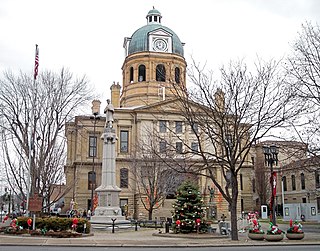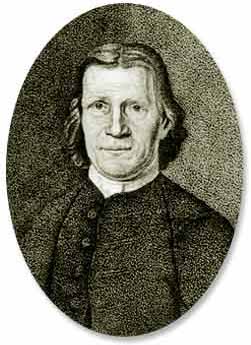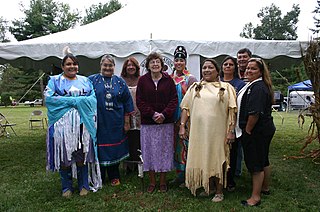
The Mohicans are an Eastern Algonquian Native American tribe that historically spoke an Algonquian language. As part of the Eastern Algonquian family of tribes, they are related to the neighboring Lenape, whose indigenous territory was to the south as far as the Atlantic coast. The Mohican lived in the upper tidal Hudson River Valley, including the confluence of the Mohawk River and into western New England centered on the upper Housatonic River watershed. After 1680, due to conflicts with the powerful Mohawk to the west during the Beaver Wars, many were driven southeastward across the present-day Massachusetts western border and the Taconic Mountains to Berkshire County around Stockbridge, Massachusetts.

Tuscarawas County is a county located in the northeastern part of the U.S. state of Ohio. As of the 2020 census, the population was 93,263. Its county seat is New Philadelphia. Its name is a Delaware Indian word variously translated as "old town" or "open mouth". Tuscarawas County comprises the New Philadelphia–Dover, OH Micropolitan Statistical Area, which is also included in the Cleveland–Akron–Canton, OH Combined Statistical Area.

Gnadenhutten is a village located on the Tuscarawas River in Tuscarawas County, Ohio, United States. The population was 1,240 at the 2020 census. It is Ohio's oldest existing settlement, being founded by Moravian Christians in 1772 and was the site of the Gnadenhutten massacre during the American Revolutionary War. It is part of the New Philadelphia–Dover micropolitan area.

The Lenape, also called the Lenni Lenape and Delaware people, are an Indigenous people of the Northeastern Woodlands, who live in the United States and Canada.

Moravian 47 is an Indian reserve located in Chatham-Kent, Ontario, with an area of 13 square kilometres (5.0 sq mi). It is occupied by the Delaware Nation at Moraviantown First Nation, a part of the Christian Munsee branch of the Lenape, and is commonly known as Moravian of the Thames reserve. The resident registered population is 457, with another 587 band members living off the reserve.
Munsee-Delaware Nation is a Lenape First Nations band government located 24 kilometres (15 mi) west of St. Thomas, in southwest Ontario, Canada.

The Gnadenhutten massacre, also known as the Moravian massacre, was the killing of 96 pacifist Moravian Christian Indians by U.S. militiamen from Pennsylvania, under the command of David Williamson, on March 8, 1782, at the Moravian missionary village of Gnadenhutten, Ohio Country, during the American Revolutionary War.
Gelelemend (1737–1811) (Lenape), also known as Killbuck or John Killbuck Jr., was an important Delaware (Lenape) chief during the American Revolutionary War. He supported the rebel Americans, known as Patriots. His name signifies "a leader." He was born into the Turtle clan, which had hereditary responsibility for leadership, he became principal chief of the Lenape in November 1778, following the death of White Eyes, a war chief and Speaker of the Delaware Head Council. Gelelemend succeeded his maternal grandfather Netawatwees.
John Henry Kilbuck — sometimes spelled Killbuck (Lenape)— and his wife, Edith Kilbuck, were Moravian missionaries in southwestern Alaska in the late 19th and early 20th centuries. John H. Kilbuck was the first Lenape to be ordained as a Moravian minister. They served the Yup'ik, used their language in the Moravian Church in their area, and supported development of a writing system for Yup'ik.

The Delaware languages, also known as the Lenape languages, are Munsee and Unami, two closely related languages of the Eastern Algonquian subgroup of the Algonquian language family. Munsee and Unami were spoken aboriginally by the Lenape people in the vicinity of the modern New York City area in the United States, including western Long Island, Manhattan Island, Staten Island, as well as adjacent areas on the mainland: southeastern New York State, eastern Pennsylvania, New Jersey, Connecticut, Maryland, and Delaware.
White Eyes, named Koquethagechton, was Chief Sachem of the Lenape (Delaware) people in the Ohio Country during the era of the American Revolution. Sometimes known as George White Eyes, or Captain Grey Eyes al. Sir William, his given name in Lenape was rendered in many spelling variations in colonial records.
Buckongahelas together with Little Turtle & Blue Jacket, achieved the greatest victory won by Native Americans, killing 600. He was a regionally and nationally renowned Lenape chief, councilor and warrior. He was active from the days of the French and Indian War through the Northwest Indian Wars, after the United States achieved independence and settlers encroached on territory beyond the Appalachian Mountains and Ohio River. The chief led his Lenape band from present-day Delaware westward, eventually to the White River area of present-day Muncie, Indiana.

David Zeisberger was a Moravian clergyman and missionary among the Native American tribes who resided in the Thirteen Colonies. He established communities of Munsee (Lenape) converts to Christianity in the valley of the Muskingum River in Ohio; and for a time, near modern-day Amherstburg, Ontario.
David Williamson (1752–1814) was a mass murderer and colonel in the Pennsylvania Militia during the American Revolutionary War. He was born near Carlisle, Pennsylvania, and led American militiamen in the Gnadenhutten massacre of the Moravian Christian Indian Martyrs, though he failed in his plan to massacre the Christian Indians in Schoenbrunn. He led Pennsylvanian soldiers in the massacre of peaceful Delaware Indians in Killbuck Island and was second in command in the Crawford expedition. David Williamson allowed his men to rape women and children in the cold snow while simultaneously killing them.
Mohican is a language of the Eastern Algonquian subgroup of the Algonquian language family, itself a member of the Algic language family. It was spoken in the territory of present-day eastern New York state and Vermont by the Mohican people but is believed to have been extinct since the 1930s. However, since the late 2010s, the language is being revived, with adults learning the language, and children being raised having Mohican as their first language.
Papunhank was born in the early 18th-century. He was a Munsee man whose ancestors were notable sachems. He spent his entire life growing up in the area around the Susquehanna Valley, a region which increasingly became embroiled in violence between settlers and Indigenous nations, including Munsee, Conoy, Nanticoke, Mahican, and Lenape. While Papunhank eventually converted to Christianity, during his early life he had been regarded as a prophet in Munsee society. Up until the 1750s he reportedly struggled with an alcohol problem but following the death of his father, he isolated himself for five days in the woods and was struck by a spiritual vision which had a profound impact on his life. He became even further devoted to God, and renounced alcohol and became a pacifist. Papunhank came to use aspects of both Christianity and traditional Munsee spirituality, and was seen as a medicine man by many of his people.
Hell Town is the name for a Lenape Native-American village located on Clear Creek near the abandoned town of Newville, in the U.S. state of Ohio. The site is on a high hill just north of the junction of Clear Creek and the Black Fork of the Mohican River.

Brodhead's Coshocton expedition was a military expedition carried out by Patriot forces against the Lenape near Coshocton, Ohio in April 1781 during the American Revolutionary War. Led by Daniel Brodhead, the Patriots engaged and defeated several Lenape warriors, massacring 16 captives before burning Coshocton and the then-abandoned settlement of Lichtenau to the ground.

The Munsee are a subtribe and one of the three divisions of the Lenape. Historically, they lived along the upper portion of the Delaware River, the Minisink, and the adjacent country in New York, New Jersey, and Pennsylvania. They were prominent in the early history of New York and New Jersey, being among the first Indigenous peoples of that region to encounter European colonizers.

Moravian Indian Grants were three tracts of land in Tuscarawas County, Ohio granted by the federal government in the eighteenth century to a group of Christian Indians. In the nineteenth century, these natives moved west, and the government sold the land to white people.









